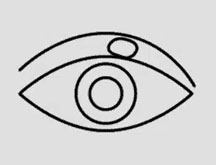
A chalazion is a painless, non-infectious lump or swelling in the eyelid. It occurs when an oil gland in the eyelid becomes blocked, leading to the accumulation of oil and the formation of a cyst-like bump. Here are some key points about chalazion:
Causes:
- A chalazion typically develops when the meibomian gland, which produces oil that helps lubricate the eye, becomes blocked.
- The blocked gland prevents the normal flow of oil, leading to the accumulation of oil and inflammation.
Symptoms:
- The most common symptom of a chalazion is a painless lump or swelling in the eyelid.
- Other symptoms may include redness, swelling, and tenderness in the affected area.
Distinguishing from Stye:
- Chalazions are often confused with styes, but they have different causes. A stye is an infected eyelash follicle, while a chalazion is not typically associated with infection.
Treatment:
- Small chalazia may resolve on their own without treatment.
- Warm compresses applied to the affected eyelid can help soften the contents of the blocked gland and promote drainage.
- In some cases, healthcare professionals may prescribe antibiotic ointments or steroid injections to reduce inflammation.
- For persistent or larger chalazia, incision and drainage may be necessary.
Incision and Drainage:
- If a chalazion doesn't respond to conservative measures, a minor surgical procedure may be performed.
- During incision and drainage, a healthcare professional makes a small incision in the chalazion to release the trapped contents.
Postoperative Care:
- After incision and drainage, warm compresses and antibiotic ointments may be recommended to promote healing and prevent infection.
- Patients are usually advised not to squeeze or manipulate the area to avoid further irritation.
Recurrence:
- Chalazia can sometimes recur, especially in individuals with a tendency for meibomian gland dysfunction.
- Good eyelid hygiene, including regular warm compresses and lid scrubs, may help prevent recurrences.
Seeking Medical Attention:
- While many chalazia can be managed at home, it's important to seek medical attention if the lump persists, enlarges, or causes significant discomfort.
- A healthcare professional can provide an accurate diagnosis and recommend appropriate treatment.
Chalazia are generally benign and don't pose a serious threat to vision. However, it's crucial to consult with a healthcare professional for proper evaluation and management, especially if there's uncertainty about the nature of the eyelid lump or if it causes persistent symptoms. If you suspect you have a chalazion or have concerns about your eye health, it's advisable to seek guidance from an eye care professional.